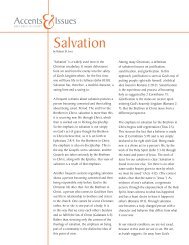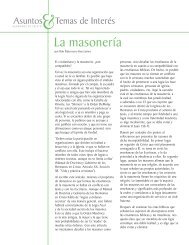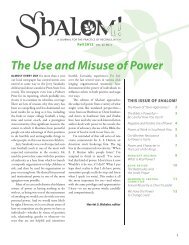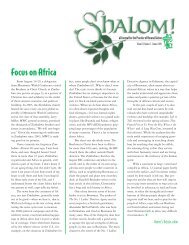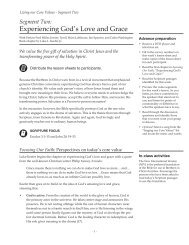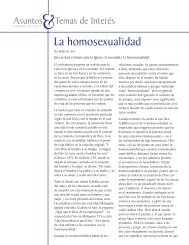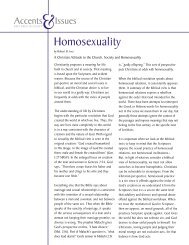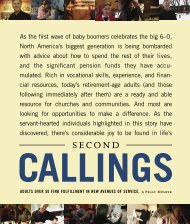Baptism and Belonging - Brethren in Christ Church
Baptism and Belonging - Brethren in Christ Church
Baptism and Belonging - Brethren in Christ Church
You also want an ePaper? Increase the reach of your titles
YUMPU automatically turns print PDFs into web optimized ePapers that Google loves.
y R. Donald ShaferWhen a person becomes a believer <strong>in</strong> Jesus<strong>Christ</strong> as Lord, then that person is beg<strong>in</strong>n<strong>in</strong>ga whole new life. Becom<strong>in</strong>g a disciple of<strong>Christ</strong> is both a personal experience <strong>and</strong>a corporate commitment. Therefore, thecelebration of such a significant event <strong>and</strong> itsmean<strong>in</strong>g for life is important.Historically, water baptism has been the<strong>in</strong>itiation ritual <strong>and</strong> practice for nearly all<strong>Christ</strong>ians. It was a highlight at the beg<strong>in</strong>n<strong>in</strong>gof <strong>Christ</strong>’s m<strong>in</strong>istry <strong>and</strong> an emphasis <strong>in</strong>His f<strong>in</strong>al words to the disciples before Hisascension (Matthew 3:6, 28:19).The observance of baptism has beenexpressed differently among <strong>Christ</strong>ian groups.They use different modes of baptism, such asspr<strong>in</strong>kl<strong>in</strong>g, pour<strong>in</strong>g, <strong>and</strong> immersion. But themajor difference among <strong>Christ</strong>ians concern<strong>in</strong>gbaptism is whether it is adm<strong>in</strong>istered at<strong>in</strong>fancy or when a person becomes a believer.The <strong>Brethren</strong> <strong>in</strong> <strong>Christ</strong> are among those whoadhere to believer’s baptism as an outwardsign of the <strong>in</strong>ner change of heart <strong>and</strong> redirectionof life. The accepted mode forThe <strong>Brethren</strong> <strong>in</strong> <strong>Christ</strong> <strong>Church</strong> is a forwardkneel<strong>in</strong>g immersion as a sign of humbleobedience. As <strong>Christ</strong> bowed his head <strong>in</strong>death, so a believer kneels or bows <strong>in</strong>submission to God. The three immersionsare done <strong>in</strong> honor of the Father, Son, <strong>and</strong>Holy Spirit.The <strong>Brethren</strong> <strong>in</strong> <strong>Christ</strong> are heirs of theAnabaptists, who understood that the NewTestament teaches baptism for believers(Matthew 3:13-17, Acts 2:38-41, Romans 6:4). Along with other groups, the <strong>Brethren</strong><strong>in</strong> <strong>Christ</strong> affirm belief <strong>in</strong> Jesus as Lord as aprerequisite to baptism.<strong>Baptism</strong> is offered to persons who obey<strong>Christ</strong> as responsible believers. Thus, ratherthan baptiz<strong>in</strong>g <strong>in</strong>fants, the <strong>Brethren</strong> <strong>in</strong> <strong>Christ</strong>provide a ceremony of dedication for smallchildren, as suggested by biblical examples (1Samuel 1:11, 24-28; Mark 10:13-14).The <strong>Brethren</strong> <strong>in</strong> <strong>Christ</strong> underst<strong>and</strong> thatbaptism <strong>in</strong> <strong>and</strong> of itself has no power. Rather,it is a symbol of the repentance the believerhas already made. It is a celebration of theforgiveness of God. We turn to the Bible forour underst<strong>and</strong><strong>in</strong>g of the rite rather than tochurch authority or tradition. The Book ofActs clearly relates believ<strong>in</strong>g <strong>and</strong> baptism.The conversion of Simon the magician(Acts 8:9-13), Peter’s account of the Gentileconverts (Acts 11:16-17), the Philippianjailor’s salvation (Acts 16:33-34), the beliefof Crispus, the synagogue ruler (Acts 18:8),<strong>and</strong> Paul’s words to the Ephesians (Acts 19:4-5), all have one th<strong>in</strong>g <strong>in</strong> common. Theseevents tie believ<strong>in</strong>g <strong>and</strong> baptism together.That people “believed <strong>and</strong> were baptized”was the order of the early church. It is clearthat baptism was a symbolic rite signify<strong>in</strong>gentrance <strong>in</strong>to the <strong>Christ</strong>ian way of life.<strong>Baptism</strong> is a sign of belong<strong>in</strong>g to the newK<strong>in</strong>gdom. The <strong>Brethren</strong> <strong>in</strong> <strong>Christ</strong> perceivebeliev<strong>in</strong>g followed by baptism as essentialto becom<strong>in</strong>g a member of <strong>Christ</strong>’s body. Forus, the body of <strong>Christ</strong> is a visible group of
people. The church is not primarily a place,a list of doctr<strong>in</strong>es or beliefs, or even anorganization. Rather it is a particular group ofpersons who are members together <strong>in</strong> <strong>Christ</strong>.It is the local congregation.In writ<strong>in</strong>g on the patterns of church life,Norman Bert describes baptism <strong>and</strong>belong<strong>in</strong>g <strong>in</strong> the early days of the <strong>Brethren</strong> <strong>in</strong><strong>Christ</strong> <strong>Church</strong>:“<strong>Baptism</strong> was the door through which thenew convert entered the church <strong>and</strong> tookthe first step on the road of discipleship <strong>and</strong>brotherhood. <strong>Baptism</strong> occurred like this:a meet<strong>in</strong>g would be called because someconverts had applied for baptism.“In this meet<strong>in</strong>g, the <strong>Brethren</strong> would listen asthe applicants testified to their experience ofthe new birth <strong>and</strong> expressed their acceptanceof the Bible doctr<strong>in</strong>es as practiced by the<strong>Brethren</strong> <strong>in</strong> <strong>Christ</strong>. After the testimonies, theassembled <strong>Brethren</strong> accepted or rejected eachapplicant. Those who were accepted werepresently baptized <strong>in</strong> a nearby stream or lake.“They regarded baptism as the first act of<strong>Christ</strong>ian obedience on the part of the newbeliever after his conversion.... <strong>Baptism</strong>was a brotherhood affair-all the brethrenparticipated <strong>in</strong> accept<strong>in</strong>g this new convert asone of themselves.”1Both the early church <strong>and</strong> the founders ofthe <strong>Brethren</strong> <strong>in</strong> <strong>Christ</strong> affirmed baptism asa sign of belief <strong>in</strong> <strong>Christ</strong> <strong>and</strong> belong<strong>in</strong>g tohis body. <strong>Baptism</strong> was the outward sign thata person not only believed <strong>in</strong> Jesus, but wasalso enter<strong>in</strong>g <strong>in</strong>to a covenant relationshipwith responsibility to the worldwide <strong>Christ</strong>ianchurch. It was a symbol of <strong>in</strong>corporation<strong>in</strong>to the church. This is consistent with theunderst<strong>and</strong><strong>in</strong>g that <strong>Christ</strong>’s body is a visiblegroup of believers. <strong>Baptism</strong> is a sign of one’sbecom<strong>in</strong>g a believer <strong>in</strong> the church universal,<strong>and</strong> the church universal is composed ofcongregations. The <strong>Christ</strong>ian is committedto <strong>and</strong> participates <strong>in</strong> a local expression of<strong>Christ</strong>’s body.Thus, baptism is the sign of a new life whichis personal but is not <strong>in</strong> isolation. It needs tobe followed by one’s commitment to a givenlocal church. A believer is baptized <strong>in</strong> themidst of a specific group. At the same timea believer is baptized <strong>in</strong>to the family of God,<strong>and</strong> that is expressed visibly by a covenant ormembership <strong>in</strong> a local church.The <strong>Brethren</strong> <strong>in</strong> <strong>Christ</strong> underst<strong>and</strong>membership as a covenant. <strong>Belong<strong>in</strong>g</strong> to<strong>Christ</strong>’s body is somewhat like marriage.It takes real commitment <strong>and</strong> work forthe covenant to have last<strong>in</strong>g mean<strong>in</strong>g.Membership is a covenant that is entered <strong>in</strong>towith <strong>in</strong>tention <strong>and</strong> love. While baptism <strong>and</strong>membership are not synonymous, they areclosely related.Each believer makes his or her covenant witha given local church. This commitment isusually called membership. Such a covenantshould occur as near to the time of baptismas practical. Our covenant with a givenlocal congregation is dependent upon acont<strong>in</strong>ued relationship. Upon relocat<strong>in</strong>g, aperson’s membership is affirmed with the newcongregation. Those who wish to covenantwith the <strong>Brethren</strong> <strong>in</strong> <strong>Christ</strong> <strong>and</strong> who havebeen previously baptized as believers are notrequired to be rebaptized.If believers underst<strong>and</strong> the commitment theyare mak<strong>in</strong>g <strong>in</strong> baptism, this will becomeevident <strong>in</strong> their love <strong>and</strong> care of othermembers of <strong>Christ</strong>’s family. To belong to <strong>Christ</strong>’schurch is to take an active part <strong>in</strong> relat<strong>in</strong>g to <strong>and</strong>build<strong>in</strong>g up the body of believers.For the <strong>Brethren</strong> <strong>in</strong> <strong>Christ</strong>, baptism is the signthat a believer is publicly beg<strong>in</strong>n<strong>in</strong>g the newlife <strong>and</strong> is becom<strong>in</strong>g a responsible member ofa congregation <strong>and</strong> denom<strong>in</strong>ation. Believer’sbaptism is <strong>in</strong>deed a significant event, adeliberate act based on personal belief <strong>in</strong>
Jesus as Lord. It is also the symbol of a newlife <strong>and</strong> belong<strong>in</strong>g to a new family. It is acommitment to a lifelong journey with fellowbelievers, an act of obedience to follow theLord <strong>and</strong> love His people.1. Norman Bert, Adventure <strong>in</strong> Discipleship



